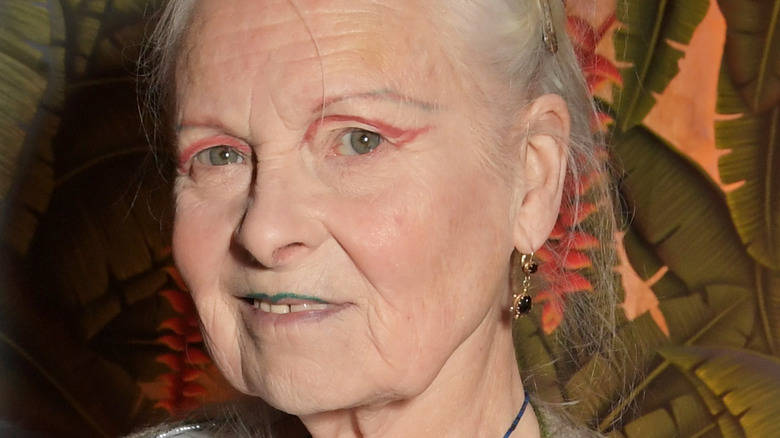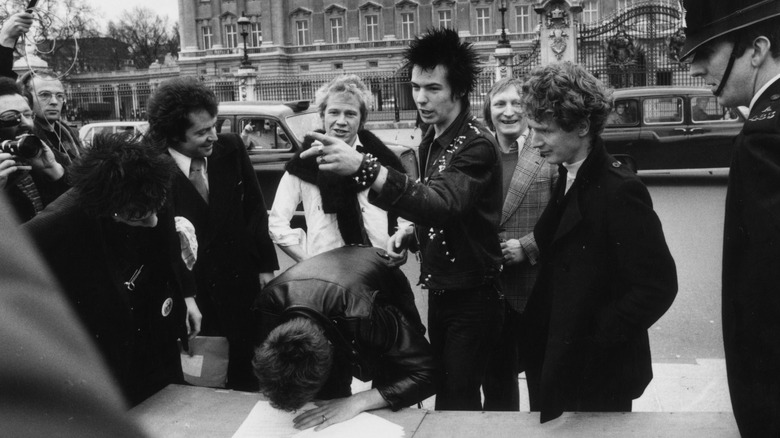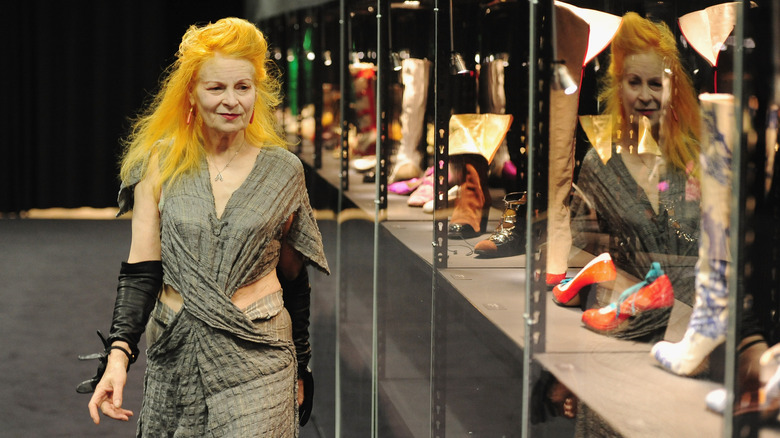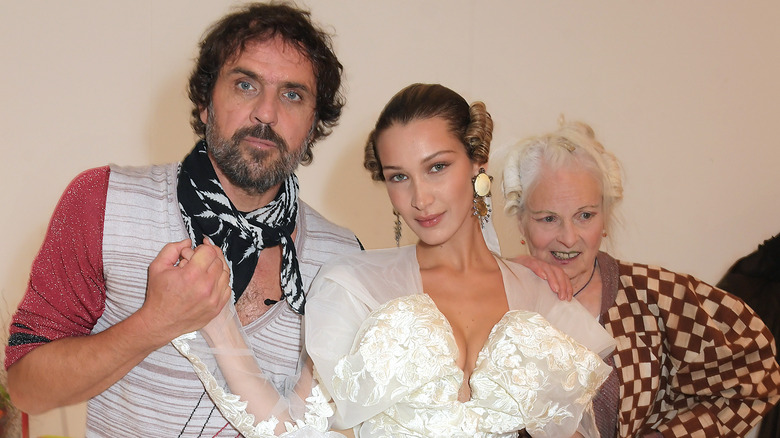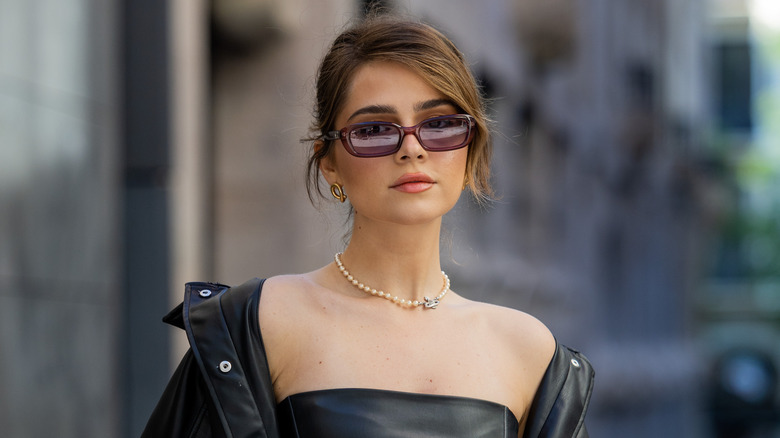How Vivienne Westwood Pioneered Punk Fashion And Remained A Style Icon For Decades
The sudden passing of Dame Vivienne Westwood has left a hole in the hearts of fashion lovers and music enthusiasts everywhere. Born Vivienne Isabel Swire, Westwood grew up in Tintwistle, a tiny village in the East Midlands region of England. "Every part [of my childhood home was stone. The walls were 18 inches thick, and I would play in the window recess," Westwood told The Times. Ultimately, Westwood's family would leave the idyllic Tintwistle for London, where the young designer made her first foray into the fashion world with a small jewelry line.
Westwood's predilection for fashion design grew as she became increasingly involved in the punk rock ethos of the 1970s. Today, her creations are easily recognizable fixtures of luxury fashion, and there are over 60 Vivienne Westwood boutiques across the globe. The English designer even received a Damehood in 2006 for her contributions to the fashion world. But how exactly did Vivienne Westwood manage to conquer the mainstream market using counterculture ideals?
Westwood's roots as a punk rock fashion maverick
Shortly after relocating to London, Westwood began a relationship with fellow designer Malcolm McLaren, who would go down in music history as manager of the Sex Pistols. McLaren and Westwood carefully constructed a series of boutiques specializing in alternative fashion, culminating with the unveiling of Sex at 430 Kings Road (later known as Seditionaries). "Malcolm and I changed the names and décor of the shop to suit the clothes as our ideas evolved," stated Westwood in her 2014 self-titled memoir.
Westwood's pieces at Sex that would become definitive punk styles included deconstructed mohair sweaters, screen-printed shirts, and bondage trousers. As far as McLaren and Westwood were concerned, nothing was too shocking for the store's shelves. "When we started to do punk, I think it was the first time people saw clothes like ours, and they could buy them from our little shop. No one was wearing anything like it," Westwood told Vogue.
Why finding original Westwood pieces is a challenge
Naturally, Malcolm McLaren was keen to dress the Sex Pistols group members in the duo's designs, which quickly made waves across the punk rock community in the 1970s. "I was very aggressive about punk in those days. It was like a you're-with-me-or-against-me kind of thing," Westwood told Interview Magazine. Her avant-garde creations spread like wildfire, adorning concertgoers from London to New York.
Today, nearly fifty years after their introduction, strong demand still exists for early Sex and Seditionaries creations. However, collectors may find it difficult to obtain original pieces from the brand's introductory collections. In 2016, Westwood and McLaren's son, Joe Corré, burned a considerable amount of the fashion house's archives in protest, including items worn by Westwood herself at the height of Sex's success. And according to Daily Mail, Westwood was so protective of her early designs that she even ordered replica outfits made for the 2022 "Pistol" mini-series to be locked away, preventing potential devaluation. Furthermore, many of the brand's initial designs were acquired for museum archives, such as the early seventies "Venus" t-shirt in the Metropolitan Museum's Costume Institute collection.
She remained committed to activism throughout her life
Westwood shocked and awed fans for decades, catapulting an unlikely subculture to the forefront of fashion. But despite her status as one of the world's most well-known designers, she was quick to point out flaws present within the garment industry. "Couture is the only sustainable fashion — meaning you can't get any more sustainable than couture. My answer is to buy less, choose well, make it last," Westwood told GQ.
A staunch critic of fast fashion, she was also a fervent activist — oftentimes, she used her platform to highlight timely causes such as climate change and economic inequality on the runway. Many of her collections showcased her political views throughout the years, from anti-fracking sentiments to issues of wealth inequality. According to Dezeen, the designer once led an impassioned discussion on sustainability at the 2019 London Design Festival. "Mostly, we buy things we don't need," said Westwood. "If we were to do without, for example, our car, we could better engage with the world instead of riding over it in comfort."
Notable fans of Westwood's designs
After dressing the likes of Sid Vicious and Johnny Rotten, Westwood caught the eye of stars like Madonna with her Autumn Winter 1983 Witches Collection, a collaboration with Keith Haring. The English designer was also a celebrated wedding dress designer, with Princess Eugenie, Dita Von Teese, and even Sarah Jessica Parker as Carrie Bradshaw modeling Viv's gowns for their big days. Former Westwood model Bella Hadid is another devoted fan of the Dame's work. "I always in my heart manifested her making my wedding dress," Hadid told Vogue. And who could forget Pharell's revival of McLaren and Westwood's iconic Buffalo hat at the 2014 Grammys?
Westwood's impact on other creatives in the fashion world is undeniable, with fans of her brand including stars like Marc Jacobs and Victoria Beckham. "Vivienne Westwood was one of the first designers who made me dream to become a designer myself and when I first started at Burberry. She is a rebel, a punk and unrivaled in her unique representation of British style," Riccardo Tisci, chief creative officer of Burberry, told Independent. Beyond her collaboration with Burberry, she also worked on collections with Buffalo London, Levi's, and Asics in recent years.
The lasting allure of Vivienne Westwood
The designer never lost her eye for eccentricity, inventing her line's legendary "Orb" logo in the late 1980s. According to Westwood's blog, the "Orb" first appeared at the designer's Autumn Winter 1987-88 show — later becoming an instantly recognizable centerpiece on everything from handbags to flats in future collections. The fashion house's other notable fixtures include its coveted corsets, first launched in the '70s, and the "Mini-Crini," a modern interpretation of the Victorian hoop skirt.
Over time, the Vivienne Westwood brand blossomed even further, leading to new legions of admirers. While the brand still favors its punk rock roots with touches of tartan and hand-scrawled designs, many of its pieces attract fans from all walks of life. It appears that even Gen Z appreciates Vivienne Westwood's eye for detail, as TikTokers are known to covet the fashion house's spin on the classic pearl choker. Although it's difficult to imagine a world without her, one thing is certain: the work of Vivienne Westwood is likely to inspire generations to come.
